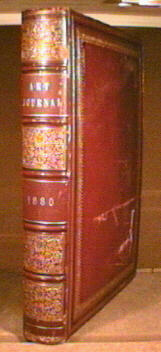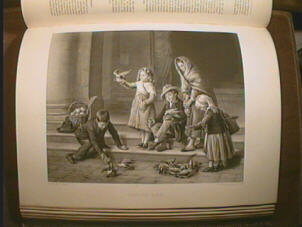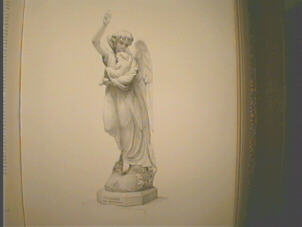| |
PAINTER.
|
ETCHER.
|
| 1. GENTLEMAN OF GOUD |
|
A Fortuny |
| 2. THE WINE-TASTERS |
E. KURZBAUER |
E. Forberg |
| 3. THE GOOSE MARKET, CRACOW. |
A. SCHONN |
Unger |
| 4. GREEKS AT PRAYER |
J. L. GEROME. H.R.A |
P. A. Rajon |
| 5. THE BOUQUET |
VON ANGELI |
E. Forberg |
| 6. THE HOUSE OF MOURNING |
CARL. HOFF |
F L. Meyer |
| 7. LITTLE BAREFOOT |
B. VAUTIER |
F. L. Meyer |
CONTENTS
Page One
ACADEMICIANS,
Lady,
Academy of Art, New South Wales
American Foliage, Studies of,
American Homes :-
Emerson's,
Longfellow's,
American Painters :-
Fairman, James,
Porter, Benjamin Curtis,
" An Artist, Sir, should rest in Art,"
Architecture in Syria and Palestine, Difference
in the Styles of,
Armed Science,
Art Club,
Art Culture, The Old System of, and the New
Art Gallery, A Projected,
Art in Continental States :-
Antwerp,
Berlin,
Berne,
Brussels,
Canada,
Chinon,
Courbevoie
Dusseldorf,
Florence,
Munich,
Paris,
Rome,
St. Germain,
Venice,
Art Industries, The Lesser:-
Irish Poplin or Tabinet,
Potteries of Scotland,
Venetian Glass-making, Revival of,
Art in Russia,
Art in the City of London,
Art in the Provinces :-
Belfast,
Birmingham,
Brading, Isle of Wight,
Brampton,
Brighton,
Bristol,
Douglas, Isle of Man,
Dublin,
Edinburgh,
Glasgow,
Halifax,
Hertford,
Kidderminster,
Leeds,
Leicester,
Liverpool,
Manchester,
Merthyr Tydvil,
Newcastle-upon-Tyne,
Nottingham,
Patcham,
Pittington
St. Albans,
Sandringham,
Selby,
Sheffield,
Southport,
Shrewsbury,
Whitchurch,
Wing
York |
Art
Jottings,
Art of the Silversmith,
Art School, St. John's Wood,
Art, Scottish,
Art Students' Home,
Art Trade Cards,
Art Union of London,
Artisan Reports on the Paris Exhibition, The,
Artistic Colours, Improvements in,
Artistic Copyright,
Artists' Colours,
Artists' Studios,
Arts of War, The,
Austria, Empress of, Visit to Ireland,
BATTERSEA
Bridge,
Beauty Types of,
Berlin Royal Academy of Arts, The,
Bethnal Green Museum, Colonel Arbuthnot's
Pictures at,
Bible Gallery Dalziel's,
Blackfriars Bridge
Premiums for Statuary Designs for,
Board Schools, Elementary Drawing in,
Bohemian Wayfarers,
Bonheur, Rosa,
Bookbinding, zoo
Books, Illustrated :-
Dalziel's Bible Gallery,
Gardens and Parks of the World, Moral Songs,
Pictures from Bible Lands,
St. Paul's Cathedral,
Sunshine and Storm in the East, Botticelli, The
New,
Bouquet, The,
Bragge's, Mr., Art Collection,
British Architects, Institute of,
British Artists :-
Burgess, John Bagnold, A.R.A.,
Herkomer, Hubert, A.R.A.,
Macallum, Hamilton,
Topham, Francis William
Burns, Statue of,
Busts :-
Cavagnari, Sir Louis,
Prince Imperial,
Bulgaria,
Byron, Statue of,
CARAPAGGIO S Frescoes,
Destruction Of,
Carpets, Hammersmith,
Carpets, Indian and Persian,
Cavagnari, Sir Louis, Bust of,
Cemeteries and Mosque Tombs, Cairo,
Ceramic and Crystal Palace Art Union,
Chambers, Mr. William, Proposal for the
Restoration
of St. Giles's Cathedral, Edinburgh,
Christmas and Season Cards,
Cimabue Procession, Leighton's,City and Guilds of
London Institute,
City Belle, The,
City of London Society of Artists,
Cleopatra's Needle,
Clothworkers' Company, Prizes of,
Cologne Cathedral Completion of,
Colours, Artists',
Colours, Poisonous,
Confessional, The
Cooke, E. W., R.A,. Will Of.
|
Copyright,
Artistic,
Corporation Plate and Insignia of Office,.
&c.,
Country Exhibitions, Statistics of,
Cousins, Samuel, R.A., Retirement Cox's, David, Sign-board at of,
Bettws-y-Coed,
DAVID
playing before Saul,
Defence of Rorke's Drift, De Neuville's, Designs
for Art Manufacture,
Original :--
Arabesque Patterns,
Balcony, Wrought-iron,
Balustrade,
Band Pavilion,
Bedstead,
Bells,
Book Covers,
Border and Carpet,
Border, Floral,
Borders, Handkerchief,
Borders, Lace,
Cabinet,
Candelabrum,Caskets,
Chalice,
Claret Jug,
Clock Case,
Column,
Cups, Silver,
Curtains, Lace,
Damask,
Epergnes, Glass,
Fender,
Floral Forms,
Frame,
Friezes
Gas Bracket,
Gates, Wrought-iron,
Grate,
Honiton Lace,
Inkstands,
Introduction,
Jewellery,
Knockers,
Lamp Vase,
Lappet Ends, Lace,
Linoleum and Border,
Loving Cup,
Napkin Rings,
Panel, China,
Panels, Majolica,
Plateaux, Porcelain,
Race Cup,
Salt-cellars,
Salver,
Sideboard
Stag and Buck Horn Furniture,
Swords, Gold,
Table Tops,
Tiles, Floor or Wall,
Vase, Gold,
Vases, Glass,
Wall Decoration,
Wall Paper,
Watch Cases,
Despatch from Trebizond, The,
Diary Blotting Pads,
Dilke, Sir Charles, MP,
Drawing Classes, Metropolitan,
|
| |
CONTENTS
Page
Two
|
|
Drawings
by Samuel Prout and William Hunt,
Loan Collection of,
Dress, Aesthetics of,
Dublin School of Art,
Dusseldorf : Its Old School and its New Academy, ECCLESIASTICAL, Art Exhibition,
Leicester,
Education in Egypt,
Elijah Ahab, and Jezebel in Naboth's Vineyard,
Enamel on Glass,
Etching : Its Relation to the Artist, Amateur,
and Collector,
Everard's, Mr., Collection,
Exhibitions :-
Ancoats,
Armour, Royal Archaeological Institute,
Art Institute,
Artists' and Amateurs' Society,
Birmingham Society of Artists,Black and White,
Dudley Gallery,
British Artists' Society,
Brown's, Mr. F. Madox, Mural Paintings,
Burlington Fine Arts Club,
Canadian Academy of Arts,
Christmas Cards,
City of London Society of Artists,
Dramatic Fine Art Gallery,
Dudley Gallery,
Ecclesiastical Art, Leicester,
Female School of Art,
Fine Art, Hertford,
French Gallery,
French water-colour Society,
German Art in Dusseldorf,
Grosvenor Gallery,
Hunt's, William, Drawings,
Incorporated Society of British Artists,
Jackson's, Rev. F. C., Drawings,
Lady Artists' Society,
Leeds Fine Arts Society,
McLean's Gallery,
Manchester Institution,
Merthyr Tydvil,
Newcastle-upon-Tyne Arts Association,
Old Bond Street Gallery,
Old Masters, Royal Academy,
Paintings on Porcelain and Earthenware,
Nottingham,
Society, hotographic
Portrait Gallery, The National,
Prout's, Samuel, Drawings,
Royal Academy,
Royal Academy Winter,
Royal Hibernian Academy,
Royal Scottish Academy,
Scottish Art, Edinburgh,
Severn's, Walter, Drawings and Sketches,
Silver-work, Amsterdam,
Southport,
Tayler's Works,
Tolmers Square Institute,
Tooth and Sons' Gallery,
Turners' Company,
Varley's Egyptian Sketches,
Walker Art Gallery, Liverpool,
Water-Colour Painters' Institute,
Water-Colour Painters' Society,
Whitchurch,
FAMILY Festivals and
Fate-days at Cairo,
Farewell, Some Words of,
Female School of Art,
Fresco Painting, Modern Process of,
Fine Art, School of Practical,
Fine Arts Society,
GAMESTERS,
Gladstone, Mr., Medal of,
Gladstone, Mr., Statue of,
Goldsmiths' Company, The,
Goose Market, Cracow, The,
Gordale Scar,
Gouda, A Gentleman of,
Great Sculptors of Modern Europe, The:-
Canova,
David d'Augers,
Schwanthaler,
Thorwaldsen.
|
Greeks at
Prayer,
Guiding Angel, The,
HALL, Mr S C., Farewell of,
Hall, Mr. S. C , Pension to,
Hammersmith Carpets,
Harvest of the Sea, The,
Hop Gardens, Kentish,
House of Mourning, The,
Hunterian Museum, Catalogue of Pictures, &c.,
Hunt's, William, Drawings,ILLUMINATED WORKS,
India Museum, The Future,
Indian Art Collections, South Kensington,
Industrial Exhibitions, Workmen's, Inquisitors, A
Visit from the,
International Exhibitions :-
Melbourne,
Sydney,
Ione,
Iron Casting, Decorative,
Italian Painting and Painters, Modern,
JACKSON's, Rev. F C.,
Drawings,
Japanese Curios,
Johnson, Dr., in the Ante-room of Lord
Chesterfield,
Jones, Burne, Designs for a Piano,
KING'S College,
LANDSEER, Thomas, Will
of,
Landseer's, Thomas, Engraved Works,
Liber Studiorum, Turner's, Lighthouses of Old,
The,
Lindsay, Sir Coutts, on Art,
Linthorpe Pottery,
Lion Hunt, The,
Literary Fund Dinner,
Little Barefoot,
London Streets Attempts to beautify,Long's Sepia
Sketches,
MACLEAY, Miss M.,
Manuscripts, Illuminated,
Massys, Quentin, the Elder,
Melbourne International Exhibition,
Mermaid of Legend and Art, The, Meryon's Charles
Etchings,
R.A., Millais, J. E.,
Monument to the late David Reid,Mosques of Cairo,
The,
Mural Fresco by Pollaiolo,
Museum or Picture Gallery: Its Functions and its
Formation,
Museums :-
Bethnal Green,
British,
Rugby School Fine Art,
Ruskin's,
Soane's, Sir John,
South Kensington,
NATIONAL Gallery, The,
"Naughty Pussy, "
Jew Curate, The,
Newton, Mr., on Greek Art,
Nile, Rising of the, and Opening of the Canal of
Cairo,
Northern Lights, The,
OBITUARY :-
Barry, E.
Boxall, Sir William,
Branwhite, C.,
Cary, F. S.,
Christen, R.,
Colnaghi, D.,
Conan, M. E.,
Cooke, E. W.,
Dafforne, J.,
Dennelle, A.,
Dodgson, G. H.,
Dupre, L. V.,
Galimard, A.,
Girardet, E. H.,
Gudin, T.,
Hall, P.,
Hart, C.,
Hering, G, E,.
Ittenbach, F.,
|
Obituary
:-
Jacobs, J.,
Jeens, C. H.,
Kruger, K.
Landseer, T.,
Lees, C.,
Lewis, C. G.,
Moore, J. C.,
Nilson, F. C.,
O'Neil, H. N.,
Powell, W. A.,
Rosc, M.,
Royer, A.,
Shayer, W.,
Swertz, J.,
Taylor, Baron
Taylor, Tom,
Thompson, Jacob,
Tourny, J. G.,
Valerio, T.,
Ward, G. R.,
Warren, H.,
Webb, J.,
Wedgwood, J.,
Old Masters, Exhibition of, at the Royal Academy,
Old Plate, Caution to Collectors of,
Ovid, Turner, and Golding, PAINTER-ENGRAVERS, Proposed
Society of,
Painting and Painters, Modern Italian,
Palm-trees and Minarets,
Paris Exhibition, Artisan Reports on Paris Exhibition, Report of Her the,
Majesty's Commissioners on the,
Photographic Images, Reversal of,
Photographic Society, Exhibition of Photogravures, the,
Picture Galleries, Attendance at, on Picture Galleries, Security of,
from a Bank
Holiday
Lightning,
Pictures, The Framing of,
Plate, Caution to Collectors of Old,
Plate, Hall Marking of,
Pollaiolo, Mural Fresco by,
Pottery, East Anglian,
Pottery, Linthorpe,
Prince Imperial, Bust of,
Professor's Lecture, The,
Prout's, Samuel, Drawings,
Putney Bridge,
QUATRE Bras,
RACE for Wealth, The,
Raikes, Robert, Statue of,
Realism in Painting,
Reaper and the Flower, The,
Reid, David, Monument to the late, Renaissance,
Forgotten Gems of the,
Reproduction, Modern Processes of,
Reverie, A,
Reviews :-
Amateur Theatricals,
Anatomy, Relationship of, to the FineArts,
Antiquary
Architecture, Gothic and Renaissance,
Art Student in Munich,
Band of Hope Review,
Bathing, Luxurious,
British Painters, Cunningham's,
British Workman,
Changing Pasture, Vale of Clwyd,
Character Sketches from Dickens,
Child's Companion,
Christmas Books, Illustrated Children's,
Colours, Handbook for Painters and Students
on the Character and Use of,
Corn-field, The,
Debrett's Peerage,
Dyce and Forster Collection,
Early Reprints for English Readers,
Early Teutonic, Italian, and French Masters,
Evening in Autumn,
Fac-similes of Thirty-three Etchings Turner for the Liber Studiorum, by,
Famous Parks and Gardens of the World,
|
| |
CONTENTS
Page
Two |
|
Reviews
:-
Figure Painters of Holland,
Fysshynge wyth an Angle, Treatyse of,
Gambler's Wife,
Gentle Shepherd,
German Fatherland, Pictures from the,
God's Acre Beautiful,
Gold and Silversmiths' Work,
Grace Ashleigh's Life-Works,
Great Artists,
Great Historic Galleries of England, Greenhouse
Favourites,
Harmony.
Hogarth, W.,
How to Write the History of Illustrated Biographies of Great a
Parish,
Artists,
Influence of Joy upon the Workman and his Work,
In the Woods,
Journals and Journalism,
Keramic Art of Japan,
Lake Scenery, English,
L'Annee Artistique,.
Lectures and Lessons on Art,
Little Masters of Germany,
Love me love my Dog,
Man of Sorrows and acquainted with Grief,
Masters of Genre Painting,
Men of Mark,
Minor Arts, The,
Modelling, Guide to,
Monuments de I'Art Antique,
Moral Songs,
Morocco ; its People and Places,
Musidora,
Necklace of Princess Florimonde, The,
Needlework,
Needlework, Designs from Old Examples,
Newcastle Public Library and Juvenile
Department, Catalogues of the,
Nile Gleanings,
Notes by Mr, Ruskin on Samuel Prout and
William Hunt,
Old, Old Story,
Our Ancient Monuments and the Land around them,
Our Boys,
Our Own Country,
Painting, Classic and Italian,
Passion Play, The Country of the, Pet Pony, The,
Pied Piper of Hamelin,
Plate, Old French,
Pottery and Porcelain,
Prince Consort Life of,
Remnants of Old Wolverhampton and its Environs,
Report of Her Majesty's Commissioners
for the Paris Universal Exhibition,
Revue des Arts Decoratifs, |
Reviews
:-
Rowlandson, the Caricaturist,
Rule of Proportion for the Human Figure,
Selections from the Literary and Artistic Remains
of Paulina Jermyn Trevelyan,
Social Science, Transactions of the Nationa;
Association for the Promotion of,
Stamford, History of,
Study,
Thoughtful Joe,
Tiny Natural History Series, The,
Turner, J. M. W., R.A.,
Uncle John's Picture Book,
Virgin, Infant Christ, and John the Baptist,
Wedgwood Art, Choice Examples of,
Well-bred Sitters,
Will Weatherhelm,
Wise Birds,
Workmen and Soldiers,
Year's Art,
Yusuf and his Friends,
River Scenery, Chapters on :-
Rivers in Mountain Limestone Districts,
Rivers in the Oolites,
Sources and Early Courses of Rivers in Granite,
Roll Call, The,
Roman Remains, Discovery of,
Rouen, Loss of its Mediaeval Character,
Royal Academicians, Lady,
Royal Academy :-
Admissions,
Attempt at Interference with its Administration,
Banquet,
Elections,
Exhibition
Hanging Committee,
Old Masters at,
Prize Distribution,
Winter Exhibition,
Royal Hibernian Academy, Royal Scottish Academy,
Ruskin, Mr., and St. Mark's, Venice,
Ruskin, Mr., on the Formation of an Art Museum or
Picture Gallery,
Ruskin Society,
St. John and the Virgin Mother,
St. Macarius, Legend of,
St. Mark's, Venice, Mr. Ruskin and,
Salon and the Royal Academy, A Comparison of the,
Salon of I880, The,
San Donato Sale, The,
Scaglieri Monument, The Brunswick,
Schools of Art :-
Dublin,
Female,
West London,
Wood, Carving, Albert Hall;
|
Scottish
Art Exhibition, Edinburgh, Sculptural Proportion,
On,
Search, The
Sepia Sketches, Long's,
Seymour, Mr. G. L., Sketches of
Sheep-Pastures, North Wale
Sign-board, The David Cox,
Silversmith, Art of the,
Sketching from Nature,
Smoke Painting,
Social Science Congress, The
South Kensington, Indian Art Collection at,
Stationery, Artistic,
Statuary, Reproduction of,
Statues :-
Bums,
Byron,
Gladstone
Raikes, Robert,
Walker, Sir A. B.,
Street Scenes, Cairo,
Strutt, Mr. A.,
Studios, The Round of the,
Suez Canal, The,
Sunshine and Storm in the East,
Sydney International Exhibition,
TABINET,
Irish,
Tapestry Painting,
Temple Bar,
Temple, Demolition of Buildings in the,
Thompson's, Elizabeth, Roll Call and Quatre Bras,
Tolmers Square Institute, Exhibition Traitor, The, at,
Turners' Company Exhibition,
VANDERBILT, Mr., Gift
to the New York A Museum,
Vasa Murrhina,
WALBERSWICK,
Walker, Sir A B., Statue of,
Warrior and Wounded Youth, The, Wass, Mr. C. W.,
Retirement from Palace Picture Gallery, the Crystal
Water-Colour Painters' Institute,
Water Colour Painters' Society,
Watson Gordon Professorship of Fine Art,
Watts, G. F., R.A.,
West London School of Art,
Whittington,
Wine-Tasters, The,
Wood Carving,
Wood Carving, School of Art,
Wood Engraving by Ladies,
Workmen's Industrial Exhibitions,
Writing Master, The,
YORKSHIRE Fine Art and
Industrial Exhibition
Report of the Committee of the,
|
|



![]()